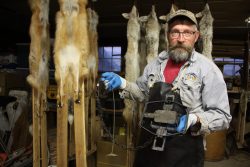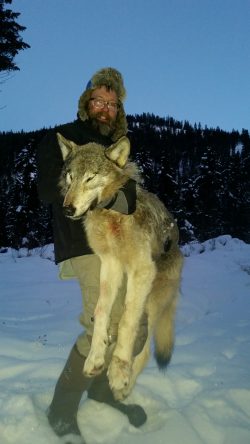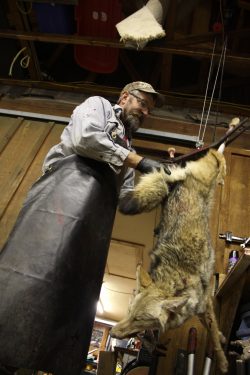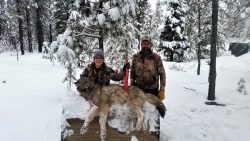A day on the Line with One of Montana’s Top Trappers Was Time Well Spent.
A Retired USFS Smoke Jumper of 26 years Dan Helterline is still active in fire fighting management activities on a seasonal basis as Dan says “The forest Service paid me to jump out of planes for 26 years, now they pay me not to jump.”
Dan grew up in Northwest Montana where he trapped, hunted and fished. Dan has travelled extensively pursuing big game around the world. As an avid angler and houndsmen Dan has focused primarily on trapping in the last six years which along with the completion of Craig O’Gormans trapping course has resulted in consistent annual harvests of over 100 coyotes and a steady increase in wolf catches. Dan’s first year he didn’t catch any wolves but on his second year he caught two, five the next year and last year he and his daughter teamed up and trapped nine wolves together.
One of Dan’s motivations for trapping wolves was the goal of making a wolf coat which he did and proudly wears whenever and wherever the temperatures are cold enough. I was fortunate to ride along with Dan one day on his trapline earlier this fall (2017) and picked his brain about wolf traps and trapping. The day was awesome as coyotes piled up in the back of his truck and Dan shared his ideas with me.
When asked about his favorite wolf trap Dan’s answer surprised me when he said it is a TS-85 (modified). The trap is built for beaver trapping so it takes some work to get it wolf-ready. Modifications include four coiling, laminating and adding a base plate so they are center swiveled. “The biggest advantage I like is they are economical. They are about half the price of some of the higher end traps and I think they perform just as well. You can get more traps out there and they are not cost prohibitive.” Dan said.
It costs about ten dollars for the modifications but the result is a trap that is ideal for the mid-winter trapping conditions in Dan’s part of the country.
Dan has a friend who is a more accomplished welder than he is who helps him with the modifications. Each year Dan has found tweaks and changes for his equipment to make them better. He had his newest generation to show which now has a trigger lip to get the dog-less contact point down below the jaw line which Dan thinks is beneficial.
The TS-85 trap has an offset cut into the jaws and Dan adds two coils, outriggers, a lamination using 1/4” cold rolled steel, shims the levers to level the jaws and adds a tab to protect the trap from biting wolves.
The trap has about a 9 inch jaw spread. The result is Dan’s go to wolf trap developed over four seasons that is in his opinion the best available design and durability for the price of about $30.
He does like other top traps on the market but attaining very many is cost prohibitive.
Dan is a big advocate of anchoring everything short with a cable stake and a shock spring. “I think that if you use long chains and drags there is a higher probability of stuff pulling out when it wraps around something solid and then you have to spend time looking for your catch. “ Dan also thinks that the catch circle is a good attractant which other wolves will re-visit later.

Dan will add ten feet of chain and a drag if he thinks there’s a chance the soil isn’t solid enough to confidently hold a wolf. A rivet swivel off the D-ring on the base plate lays flat under the trap which Dan likes. At least one more crunch proof swivel is added to the 12 -18 inches of chain that precedes a disposable stake held on by a lap link.
All swivels and connections are tack welded finishing out the trap and rigging modifications. Additional enhancements to trap performance are gained through the use of black heavy screens that accompany each trap which Dan buys from O’gorman. Dan says the screens “help everything become real solid.”
Dan uses a very similar set up for his extensive coyote trap line too except that the traps and screens are smaller. “Wolf trapping is a lot like coyote trapping; only it’s on steroids” Dan explained.
“I like using a dirt hole set, that’s probably my highest producing set and I always make the pan on the trap a little lower than the surroundings to make them step down and commit to that low spot.” Dan said.
He also uses subtle blocking to make wolves step right where he wants them and doesn’t have a regimented number of inches from the dirt hole because of it. Dan always carries an auger of some type to make dirt holes. A four inch auger works well for wolf sets and he makes the holes as deep as he physically can. A “big showy hole” is his preferred dirt-hole design and he uses a quality lure in the bottom of hole.

“Get the lure deep in the hole that way a wolf will be interested in working it where they can’t dig the bait out. On several occasions I’ve had traps frozen down and wolves dug the bait out and rolled in it. That’s typically what they do, they aren’t after it as a food response, and it’s more of a rolling response.” Dan explained that by having the bait buried deep the wolves will spend more time at the set trying to get to the bait/lure.
And Dan noted that both times when wolves dug up the lure he re-made the set and caught them on the next check or second one showing that wolves will return and work a set multiple times until they are caught.
Dan also uses tainted muskrat carcasses for bait in dirt-hole sets. The set requires a fairly big hole to fit the whole carcass in. Sometimes the carcass is all that is used, other times he will add gland lure or commercially made paste bait to the backing as an additional attractant.
Dan likes to gang set using various lure/bait combinations with traps set about 75 to 100 yards apart.
“I’ll go around the bases of trees in winter and kick the ground. If the ground moves that’s a good set location as long as it intersects with wolf sign.” Dan said. Explaining that weather proofing and choosing set locations go hand in hand.
Dan runs about 60 wolf traps and with a 48 hour trap check requirement he divides his line into two sections checking each on alternate days. Although Dan catches most of his wolves using dirt hole sets he won’t pass up the opportunity at natural pee-posts and he will collect wolf turds for flat sets. When it comes to lures and baits Dan uses stuff that’s similar to what he uses for coyotes but is looking forward to trying some newly available wolf specific gland lures this season.
Dan is continually experimenting with different sets, lures and locations but has certainly settled on his trap of choice – the modified TS-85.

“Two words; patience and persistence” Dan said when asked what advice he had for new wolf trappers. “Wolves will come through your area once every two weeks with their travel cycles. Keeping traps working is probably the biggest challenge.”
“You only need to do two things to trap a wolf; set a trap where wolves will step and make sure the trap fires when it does” Says Dan, quoting his favorite opening line used during wolf trapping demonstrations. As funny as that sounds though, it really is the foundation of Dan’s trapping philosophy.
Location is paramount for wolf trapping success but the very spot each trap is set is just as important. Dan takes considerable time during pre-season scouting mapping out his trap line and gets information from houndsmen about wolf activity throughout the winter. Dan then makes sure that his trap placement is weatherproof by checking the soil conditions at the base of trees before deciding to set a trap.
Dry waxed dirt is his bedding medium of choice but as Dan makes clear, “nothing is fool proof.”
One notable feature in Dan’s pickup truck is a conspicuous .22 rifle. The bright pink youth model Cricket rifle is cute but it accompanies his trapping tools and is seen in every photo he has with his 12 year old daughter Alexis who proudly traps with her Dad and owns the little rifle.
When I asked Dan about his favorite trapping memory the conversation quickly turned to his daughter who trapped her second wolf last season on Christmas day. That morning she was playing with electronics and wanted to stay home but Dan said “Nope, get your camo clothes you just opened and let’s go check traps.” Her second wolf was a memory that will last her lifetime and there is no doubt that having her accompany him on his trap line is as much a part of what Dan does as any other aspect.

I really enjoyed my time with Dan and learned a lot. If you know a successful trapper who is willing to let you ride along just drop everything and go!